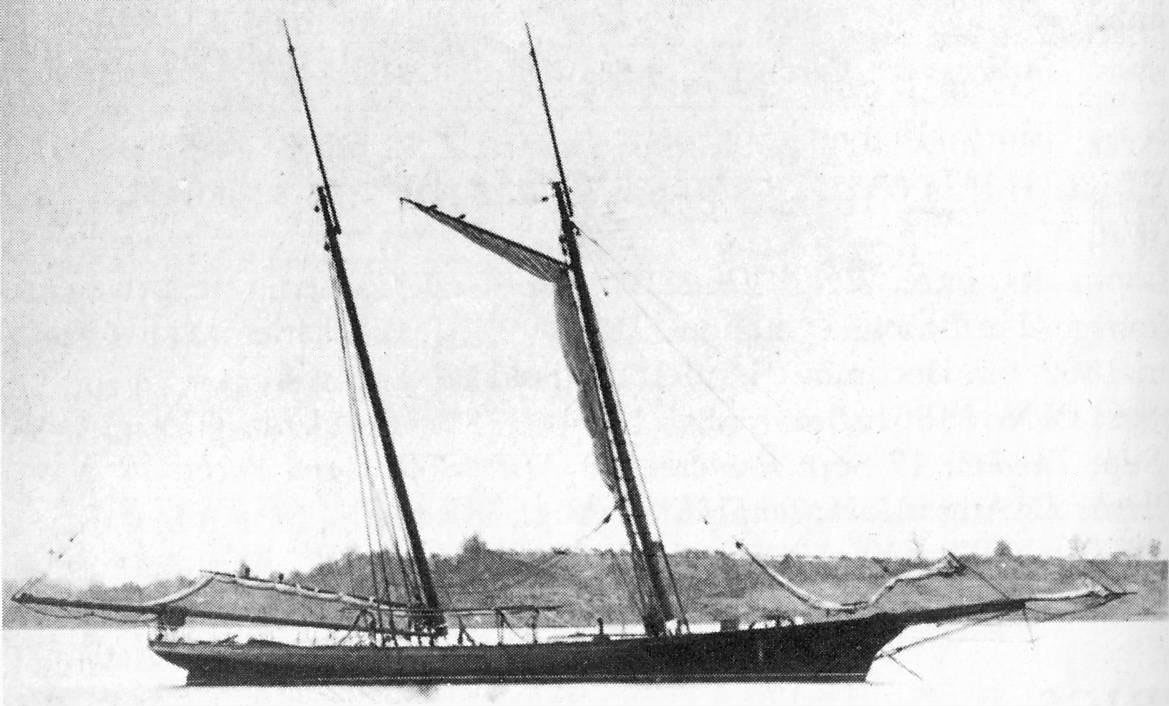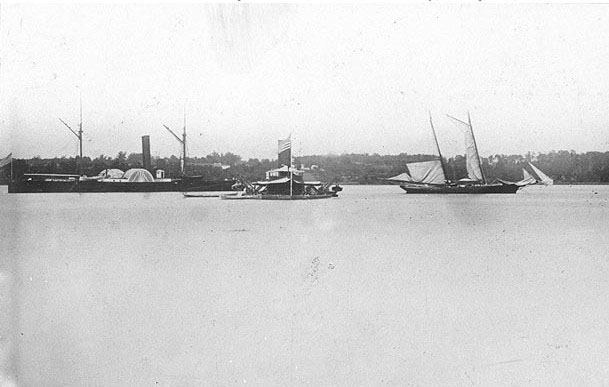
The schooner yacht America of 1851 is arguably the most famous yacht in history. I have always wished people would identify and credit published photos, but I can’t tell where this picture has been hiding; perhaps in the archives of the US Naval Academy.
Until recently, we could not be sure exactly what she looked like in her racing rig. We do have an accurate set of lines taken off her while in an English dry-dock, but for overall appearance we had to go on newspaper sketches and stylized illustrations from the 1850s. America was modified after the Civil War; stern lengthened, rig modernized, and she was given a long spike jib-boom.
The detail is stunning. Here was America about 15 years after her historic race; the period before she was modified. I think she carried the flying jib-boom when she won the Cup, but not the fore-topmast. The camera was just above the height of the rail. The schooner is rolling gently to port in the buoyant manner of long keelers with internal ballast, unlike stiffer modern boats.
The standing foresail overlapped the main like a modern genoa jib. With the cable slipped, the vessel could be underway in short order simply by letting go the brails and sheeting home. This was a common arrangement in slavers and privateers, which I feel the original design reflected more so than the New York pilot schooner of anecdote. While the Steers brothers built pilot boats they built more than fifty yachts.
It is most gratifying to see that early engravings of her were not as exaggerated and stylized as we might have thought. Both the rig and the transom had much more rake than subsequent ‘replicas’. Crews of the schooners I sailed in thought a boom of 40ft a pretty fair length, but the one in the photograph has to be all of 60 feet, with stirrups and footropes like the mainyard of a square-rigged ship.
In the picture the coils of the main sheet are thrown over the boom to dry out. She does not have the luxury of a boom gallows, but it is probable that a portable iron boom crutch was hidden from view by the mainsheet coils. I am guessing they used the term “jib” for that huge sail on the forestay. One account says the 1851 racing crew did away with the club-foot boom. America was steered with a tiller of not particularly large proportions. We can just make it out abaft the main companionway. I seem to recall one example on display in the premises of the New York Yacht Club.

When I sailed in the Goudy & Stevens-built namesake, I was always trying to imagine what it would have been like in the original America. Obviously, our speed was compromised by an enormous propeller and two 400lb anchors dipping into every wave. Also, the new boat was deeper in the water by at least a foot due to the ballast keel which also meant steeper dead-rise. In her extremely hollow bow, the new America carried her anchors, all her chain-cable and a very large windlass. I am sure she is ‘wetter’ than the original when driven to windward. None the less, she is a very pretty boat under the water. The narrowness forward of the beam is implied by the ‘channels’ carrying the foremast shrouds outside the rail in both vessels.
A detail this photograph of the old America confirms is the use of one double sheaved block to carry both spans of the peak halyards. I would dearly love to know how olden-day bosuns dealt with the attendant problem. We found dangerous friction on the single shackle holding this block to the masthead and the original America would have had perhaps twice the weight suspended at that point. Carrying the load on the topping lift is impractical and causes problems in a seaway.
I love this old photograph of the America. Looking at her condition it is hard to believe she had been scuttled in a muddy river. Her ‘Bristol’ presentation was a credit to the US Navy in the days of sail. I am guessing the scene was somewhere off the Naval Academy at Annapolis, and not long after Grant took Richmond. Another photograph from the period at that spot is quite well known. It shows a side-wheeler, a turreted monitor and a schooner drying her sails after rainfall. I think we can say for sure this is also the schooner yacht America, pretty much as she would have appeared at Cowes.
